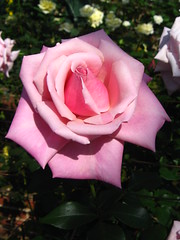Inspired by the beautiful weather, I spent some time during our last class reflecting on why being outdoors, being out in the world, is so important. The short piece below is a work in progress. It may become larger. It may become a poem. At this point, I'm not sure, but I'm looking forward to finding out.
It's the beginning of April. No showers today. Instead, a dappled stream of sunlight waves softly across my page as I sit outside. It's my last class at Longwood Gardens, and I'm taking full advantage of the weather in order to climb the steps to the top of the waterfall at the far end of the gardens. The last time I did this, nearly seven months ago, I was a very large at nine months pregnant.
In the heat of August, I trudged up these stairs, so slowly that my not-quite-two-year-old beat me to the top. Happily, I found this bench waiting for me there and carefully backed my way onto the wooden slates, vowing I would not move again
So on this beautiful spring morning, I knew I needed to return, a bit lighter this time. Last I was here, I was on the cusp of a new adventure - mother to two instead of one. Now, as this class comes to a close, I am about to begin another adventure. How do I carve out time to connect and reflect to the natural world once this class is over? How do I continue to find time to write about my experiences in nature?
 A morning literacy activity has us working in partners to scour through children's books. We're to choose one as a model. How might we use its structure as a springboard for our own reflections on this course?
A morning literacy activity has us working in partners to scour through children's books. We're to choose one as a model. How might we use its structure as a springboard for our own reflections on this course?
The important thing
about Longwood is
that it is history
growing beneath your feet,
a mission cultivated by DuPont,
an education that reaches all ages and
overwhelms the senses.
It draws you in.
It is a diverse abundance
of life -
of trees, flowers, grass.
But the most important thing
about Longwood is
that it is history growing
beneath your feet.
Inspired by reflections on my nature collage.
Cherry Orchard
Tailgating to get to its heart, dangling from the gate of the pick-up,
dangling from the gate of the pick-up,
bounding over irrigation hoses
to find the sweetness at the center
of the orchard.
We cram our cheeks full,
spitting pits with force.
A contest of cousins,
juices dribbling off our chins
onto hand-me-down t-shirts.
Skinned knees and shabby shoes,
we are content,
surrounded by the branches
of family
rooted deep in this orchard.
Let's face it. I am a tech geek. I have my final project posted to the web halfway through our class. I'm online constantly. My laptop is never really all that far from me. But what I've also realized is that I am a writer.  I think my connection to technology is my way of finding an audience for my writing. When we were asked last week to either do some extensive reading or writing about nature, I choose writing, one of the few people in our class that opted to write rather than read. And in part, I think that I chose to write because I needed to find a way to make connections between what we discussed in class with what I reflected on while writing in the gardens. I needed to find a connection between my interest in technology the with my love of nature.
I think my connection to technology is my way of finding an audience for my writing. When we were asked last week to either do some extensive reading or writing about nature, I choose writing, one of the few people in our class that opted to write rather than read. And in part, I think that I chose to write because I needed to find a way to make connections between what we discussed in class with what I reflected on while writing in the gardens. I needed to find a connection between my interest in technology the with my love of nature.
Different from what some might think, technology and nature are not opposed. And this is what I think my final project for this course will focus on. In fact, thinking about the future, we'll need to find ways to use technology to foster a love of the natural environment. What might that look like? How can I do this in my classroom?
 I can't stop clicking photos of the lilac painted rose blooms. I'm not trying to capture how they look, although with their delicate petals open to perfection they certainly are breathtaking. But it is their perfume that's intoxicating. I think I'm trying to preserve this delicate sweet scent on film with each click, hoping that I'll find a way to take this scent home with me.
I can't stop clicking photos of the lilac painted rose blooms. I'm not trying to capture how they look, although with their delicate petals open to perfection they certainly are breathtaking. But it is their perfume that's intoxicating. I think I'm trying to preserve this delicate sweet scent on film with each click, hoping that I'll find a way to take this scent home with me.
And I'm not one that fawns over roses.
In fact, generally speaking, I hate them. Okay, hate is too strong. Let's just say I powerfully dislike them. I've been hacking away at my two climbing roses for the last three years, butchering them back nearly to the ground each spring, secretly hoping they might not make it. But this hacking only encourages them to send out stronger, thornier vines that wind and tangle their way around the air conditioning unit, up the brick of our home, scratching at our window screens, crowding out other nearby blooms.
I didn't plant them. Would never choose roses for myself. Too girly. Too showy. Too predictable. I never really liked their smell, at least not the rose scented perfumes that crowd out all other senses when you walk through the cosmetics section of any department store. Its imitation smells sickly sweet. But not these roses in front of me.
Blooms in every shade of pink, crimson, and ivory fill this long corridor of a room. They are overwhelming. Petals unfurled in blooms nearly as large as my hand, and a smell so sweetly delicate, so clean, honest.
Too girly.
Too showy.
I'm not one to fall over flowers.
Rose perfumes too sickly sweet.
But these blooms blush
every variation of baby pink,
innocence and crimson.
Petals unfurl in blooms as
large as my palm
and share with me a
secret, sweetly delicate,
so clean and honest.
I have dropped my journal in the garden. These pages flecked with soil, water sends my ink scurrying toward the edges of the page. 


 Twitter/jenniferward
Twitter/jenniferward YouTube/teacherward
YouTube/teacherward Del.icio.us/msward
Del.icio.us/msward GMail/ms.jen.ward
GMail/ms.jen.ward Blog/Teacher Et Cetera
Blog/Teacher Et Cetera